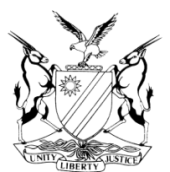4
REPUBLIC OF NAMIBIA

HIGH COURT OF NAMIBIA, NORTHERN LOCAL DIVISION
HELD AT OSHAKATI
REVIEW JUDGEMENT
Case Title: The State v Tuhafeni Sheehandje | CR No.: 19/2022 Case No.: OND-CRM-573/2021 | |
Division of Court: Northern Local Division | ||
Heard before: SALIONGA J et MUNSU AJ | Delivered on: 19 April 2022 | |
Neutral citation: S v Sheehandje (CR 19/2022) [2022] NAHCNLD 41 (19 April 2022) | ||
The order:
| ||
Reasons for the order | ||
MUNSU, AJ (SALIONGA, J concurring): [1] The accused in this matter was charged with two offences, namely, housebreaking with intent to commit a crime unknown to the State (count 1) and housebreaking with intent to steal and theft (count 2). In respect to count 2, I am of the view that the proceedings are in accordance with justice. [2] The allegations in count 1 are that on 13 February 2021 at or near Ondangwa in the district of Ondangwa the accused did unlawfully and intentionally break and enter the bar of Nakalenga Sirkka with intent to commit a crime unknown to the State. He pleaded guilty to the charge and the court questioned him in terms of section 112 (1) (b) of the Criminal Procedure Act, 51 of 1977 as follows: ‘Q: Were you forced or influenced by anybody to plead guilty? A: NO Q: Are you pleading guilty freely and voluntarily? A: Yes. Q: Why do you plead guilty? What did you do wrong? A: I broke the bar and went inside to steal the things (my underlining) Q: When did you not do that? (sic). A: 13/2/2021 Q: Where? A: Ondangwa Q: How did you enter the bar? A: I broke in by cutting a hole to enter into the bar the zinc sheets of the bar C: What did you use to cut? A: A scissor C: Was the zinc sheets of the bar in good condition before you cut it open? A: Yes it was Q: what did you do inside? A: my intention was to go inside and steal (my underlining). Q: what exactly did you intend to steal? A: I intended to go and steal money (my underlining). Q: Where was the money? A: I don’t know Q: what did you do after breaking and entering? A: I was just standing inside Q: did you have any right to break and enter the complainant’s bar? A: no Q: did you have any right to take the complainant’s money or intention to go and steal? A: no Q: Why did you do this? A: I wanted to assist myself with the money Q: did you know you were doing something wrong and unlawful to break and enter into someone’s property in your case to cut the zinc to enter with intention to go and commit a crime? A: yes I know Q: do you know that your actions are punishable by law? A: Yes I know Judgment: court is satisfied the accused has admitted to all the elements of the offence charged. (my underlining) State do you accept plea of guilty? VERDICT: GUILTY AS CHARGED (my underlining). [3] Among others, the following query was addressed to the learned magistrate: ‘On count 1, the accused was charged with the offence of housebreaking with intent to commit a crime unknown to the State. During questioning in terms of s 112(1)(b) of Act 51 of 1977, the accused stated that he wanted to go and steal. Is the conviction on count 1 (guilty as charged) proper?’ [4] The learned magistrate replied as follows: ‘The accused indicated that he broke the bar and went inside to steal money and upon admission to the elements of the offence and further that it was his intention and on that basis the court convicted him.’ [5] The verdict retained by the learned magistrate (guilty as charged) means that the accused was convicted of the offence he stood charged with i.e. housebreaking with intent to commit a crime unknown to the State. It is evident from the questioning that the accused’s intention at the time of breaking was to steal. In S v Tjavara1 January J had the following to say: ‘[5] Housebreaking with intent to steal is a competent verdict for housebreaking with intent to commit a crime unknown to the state in terms of s 262(2) of Act 51 of 1977. It made no sense to convict an accused of an offence to the prosecutor unknown when he has admitted the commission of an actual offence.2’ [6] In the result I make the following order:
| ||
Judge’s Signature | Comments: | |
MUNSU AJ | NONE | |
SALIONGA J | NONE | |
1 S v Tjavara (CR 04/2020) [2020] NAHCNLD 08 (17 January 2020).
2 See: S v Kharuxab 2008 (1) NR 345 (HC)